Oxidation of glucose
1/32
There's no tags or description
Looks like no tags are added yet.
Name | Mastery | Learn | Test | Matching | Spaced |
|---|
No study sessions yet.
33 Terms
The complete oxidation of glucose into co2 and h20 has three main stages
Glycolysis + Pyruvate Dehydrogenase complex
TCA/ Citric Acid cycle
Electron transport chain
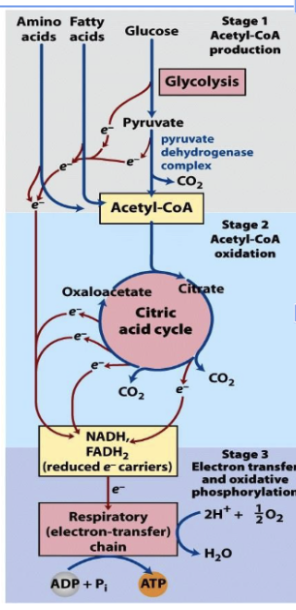
we see oxidation in small steps
Where do the stages of glucose oxidation take place?
glycolysis + Pyruvate dehydrogenase - cytoplasm
TCA cycle → in mitochondria
ETC → inner mitochondrial membrane
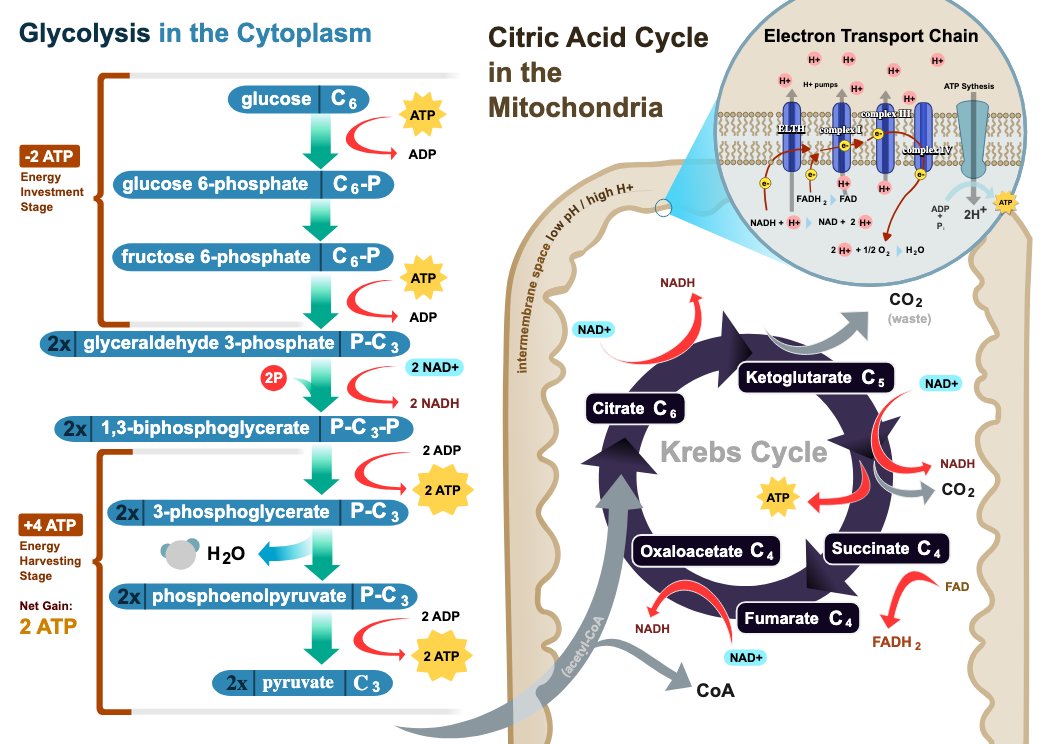
How do organisms store glucose
animals store glucose as glycogen
plants store glucose as starch
What does glucose get converted into during glycolysis?
Pyruvate
What happens to pyruvate when there is no oxygen in human cells?
It is converted to lactate to regenerate NAD⁺.
What happens to pyruvate in yeast or plants under anaerobic conditions?
It is converted to acetaldehyde, then to ethanol.
Why is converting pyruvate to lactate or ethanol important under anaerobic conditions?
It regenerates NAD⁺, allowing glycolysis (and ATP production) to continue.
Charge of glucose and implications
glucose is a polar molecule, meaning it has an uneven distribution of charge.
implication: because of its polarity it cannot pass through the lipid bilayer of the cell membrane by simple diffusion. BC the lipid bilayer is made up of fatty acids that are hydrophobic and repel polar moelcules.
If glucose is too polar to get into the cell after it was digested and entered bloodstream then how does it get in?
the body uses proteins called GLUTs (Glucose transporters embedded in the membrane to faciliatate the movement of glucose from the bloodstream into the cell
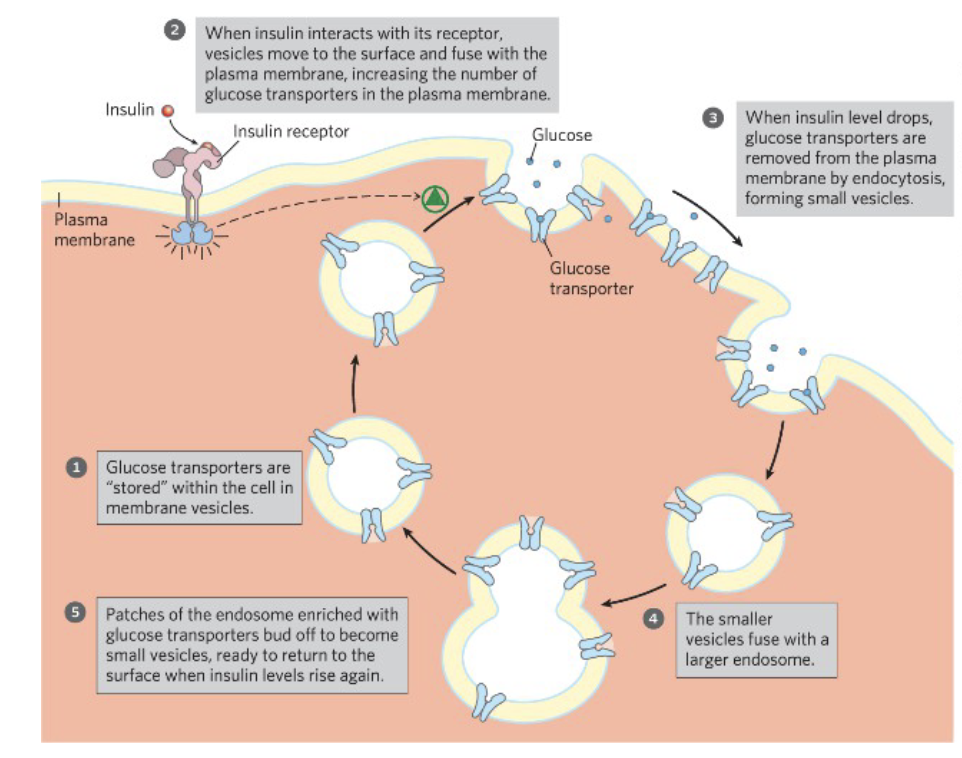
How does insulin help with glucose uptake?
It stimulates GLUT transporters to move glucose into cells.
What happens in diabetes regarding glucose transport?
Blood glucose is high, but it is not taken up into cells properly, causing the body to "starve" despite having plenty of glucose.
What is the only metabolic pathway that provides energy under anaerobic conditions?
Glycolysis
fermentation doesnt produce ATP
Where does glycolysis occur?
in the cytosol of the cell
How many steps in glycolysis?
10 steps divided into 2 main phases
The 2 phases of glycolysis
Preparatory Phase (Steps 1–5):
Payoff Phase (Steps 6–10):
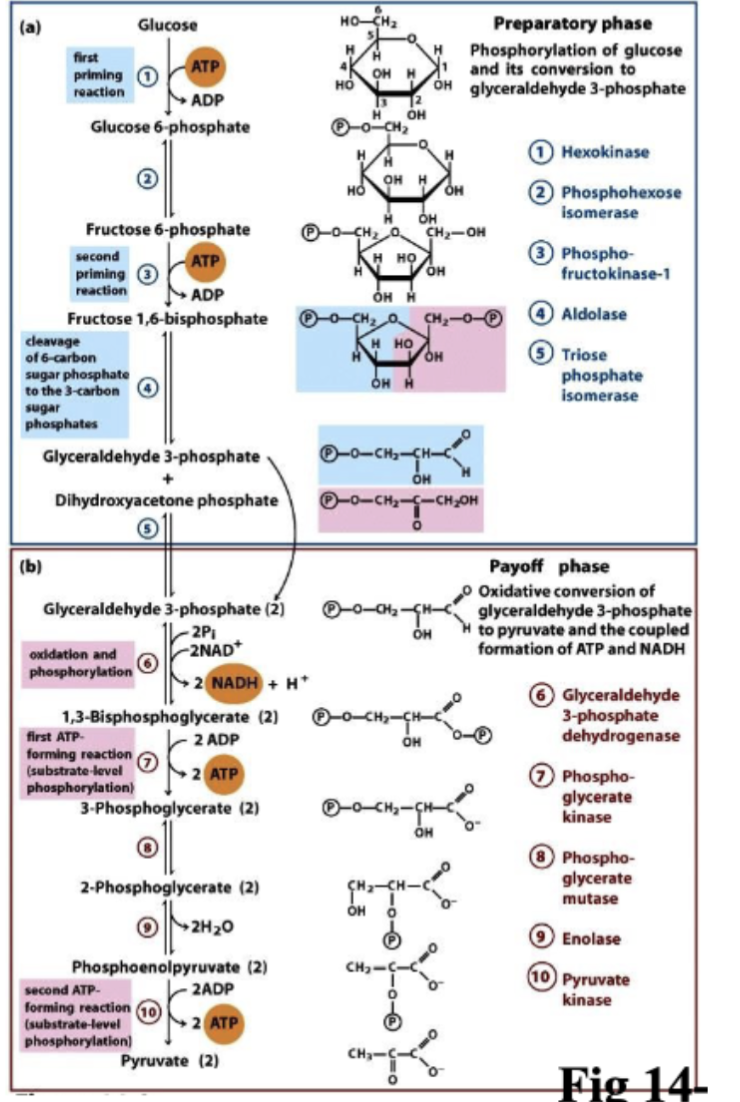
Prepratory phase
Glucose is phosphorylated using 2 ATP
Activate glucose.
Enzymes like kinases are involved (a kinase adds a phosphate group).
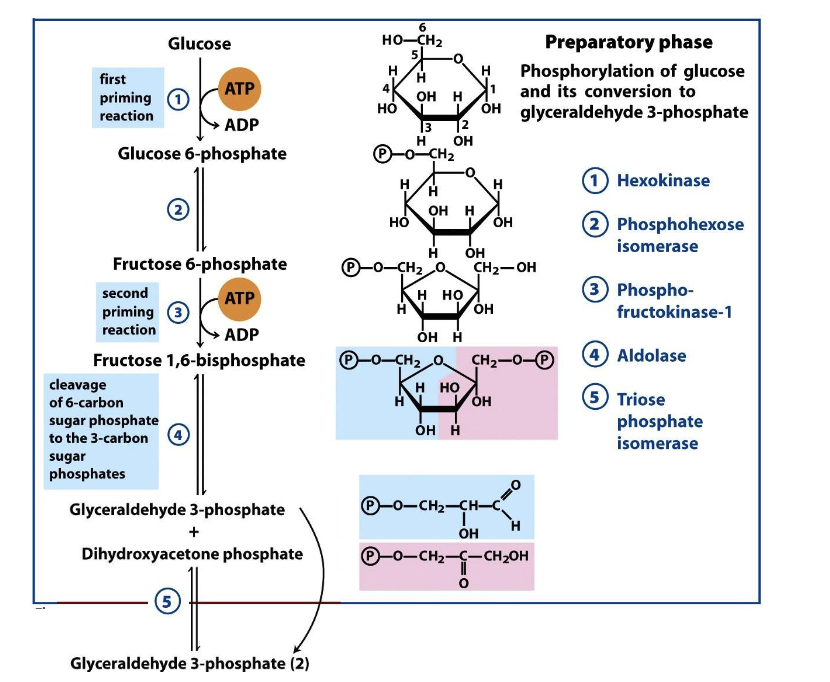
Prep phase: STEP 1: Phosphorylation of Glucose
After glucose enters cell Hexokinase enzyme transfers a phosphate group from ATP to glucose forming ADP
The product is glucose-6-phosphate
Why? → this activates glucose and makes it more reactive
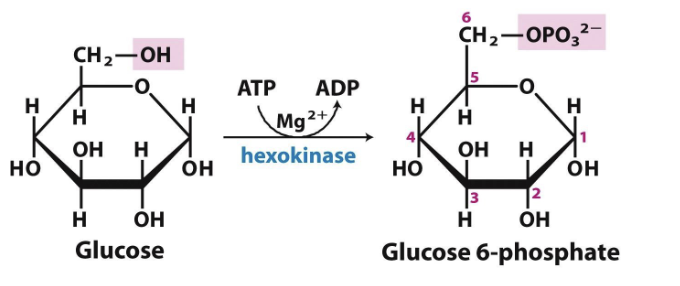
Isozymes
Isozymes are enzymes that catalyze the same chemical reaction but are encoded by different genes.
How many isozymes of hexokinase - the enzyme responsibel for phosphorylating glucose in step 1?
4 hexokinase (I-IV)
How do Hexokinase isozymes differ in their kinetics?
Hexokinase I–III: Low KMK_MKM (~0.1 mM) → High affinity for glucose
Hexokinase IV: High KMK_MKM (~8 mM) → Low affinity, only active when glucose is abundant (e.g., after meals)
PREP Phase step 2: Isomerization
The glucose ring opens rearranges and closes as a fructose ring.
this step is catalyzed by phosphohexose isomerase
now called Fructose 6-phosphate
PREP Phase step 3: Second Phosphorylation
Phosphofructokinase-1 (PFK-1) adds a phosphate group from ATP to fructose 6-phosphate
this creates fructose-1,6,bisphosphate with phosphate groups on two different carbons
molecule is more symmetrical now
ATP→ADP
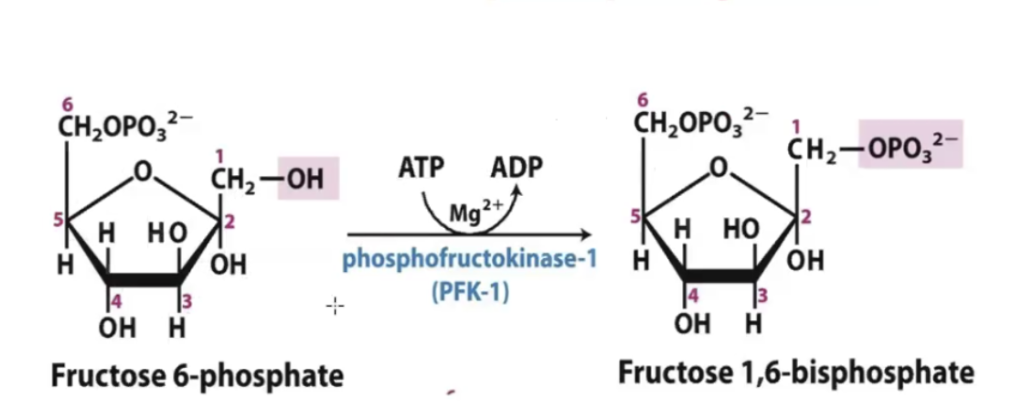
Bisphosphate vs Diphosphate
Bisphosphate: has phosphates in 2 diff positions
Diphosphates: the phosphates are connected to one another
PREP PHASE step 4: Cleavage of fructose-1,6-bisphosphate
The enzyme aldose splits the 6 carbon fructose-1,6,-bisphosphate into two 3-carbon molecules:
Glyceraldehyde-3-phosphate (G3P) (an aldose sugar)
Dihydroxyacetone phosphate (DHAP) (a ketose sugar)
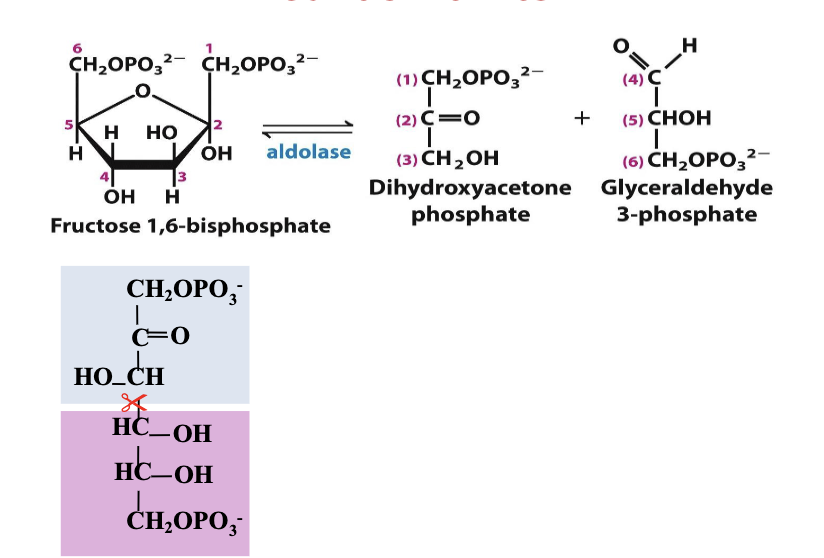
PREP PHASE step 5: Interconversion
Dihydroxyacetone phosphate (DHAP) is quickly converted to glyceraldehyde-3-phosphate (G3P) by the enzyme triose phosphate isomerase.
This is an isomerization reaction that shifts the carbonyl group from the middle to the end to form an aldose
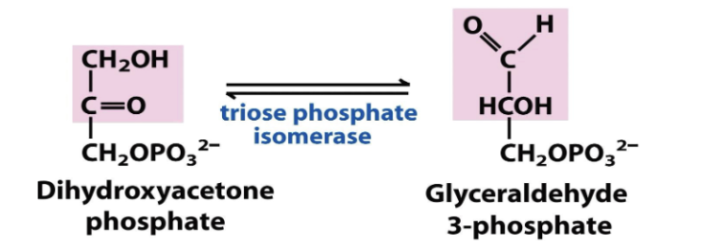
from this point forward we have two G3P molecules to proceed to the next phase
Payoff phase
Produces 2ATP and 2NADH and 2 pyruvate per glucose molecule
produces these through substrate level phosphorylation and oxidation
PAYOFF PHASE step 1: phosphorylation and oxidation
G3P molecules are oxidized and the aldehyde group is converted into a carboxylic acid
Nad+ is reduced to NADH
Pi is added to phosphorylate
the end result is a mixed anhydride (intermediate) called 1,3-bisphospholycertae (1,3-BPG)

per glucose moleucle (bc there were 2 G3P) we form 2 NADH from this step
high energy
PAYOFF PHASE step 2: substrate level phosphorylation
1,3-bisphosphoglycerate (1,3-BPG) donates a phosphate group to ADP forming ATP
result is 3-phosphoglycerate (more stable)
this step generates 2 ATP bc there are two molecules
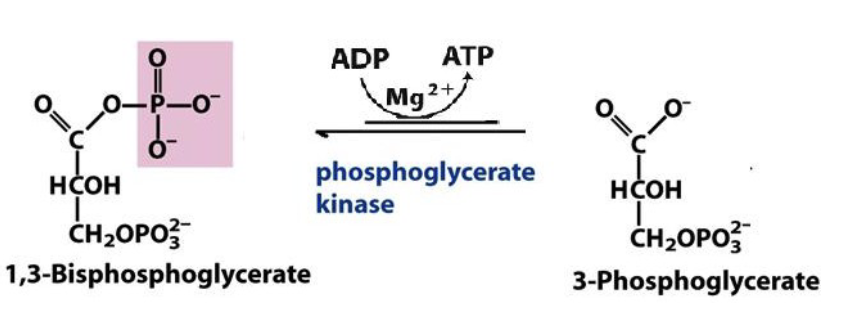
PAYOFF PHASE step 3": isomerization
Phosphoglycerate mutase (an isomerase) moves the phosphate group from the third carbon to the second carbon
end result is 2-phosphoglycerate
PAYOFF PHASE Step 4: Dehydration
Enolase enzyme removes a water molecule from 2-phosphoglycerate
this dehydration forms a new double bond
End result is phosphoenolpyruvate (PEP) → a high energy molecule
PAYOFF STAGE step 5: Second substrate level phosphoylation
Phosphoenolpyruvate (PEP) donates its phosphate group to ADP forming ATP
The product is pyruvate, which initially forms as enolpyruvate, a less stable form.
Enolpyruvate tautomerizes (spontaneously shifts) to ketopyruvate, the more stable form.
produces 2 ATP and 2 pyruvate.

X is an inhibitor of the enzyme phosphoglycerate mutase. In an anaerobic system that is metabolizing glucose as a substrate, which of the following compound would you expect to accumulate, following addition of X?
A. glucose-6-phosphate
B. phospho-enol-pyruvate
C. 3-phosphoglycerate
D. 2-phosphoglycerate
E. Glyceraldehyde 3-phosphate
If we have a chain and 3 enzymes to catalyze each reaction, what would happen if we inhibited enzyme 2? Wed get a build up of b and well get less of C and D

so we know that at the payoff step mutase isomerizes the 3-phosphoglycerate to produce 2-phosphoglycerate - if mutase becomes an inhibitor than the molecule its supposed to function on will accumulate
answer: 3-phosphoglycerate
The first reaction in glycolysis that results in the formation of an energy-rich compound (i.e., a compound whose hydrolysis has a highly negative ΔG'°) is catalyzed by:
A. glyceraldehyde 3-phosphate dehydrogenase
B. hexokinase
C. phosphofructokinase-1
D. triose phosphate isomerase
A
we know this bc. its the first reaction to result in somethign energy rich like NADH